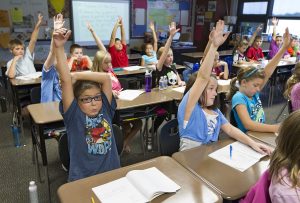Our Young People and the Imperative of Social-Emotional Learning

Courtesy Penn Live
Our public schools have become the focus of our efforts to support youth mental health. Many parents are stressed beyond imagination because of the pandemic, flooding, and many other pressures, and they look to their schools to repair what’s broken.
But is it right to place the entire burden on the schools?
Teachers are teachers, not mental health professionals. The innate human skills of our best teachers can provide help and direction for children in their care but they would be the first to say they’re not mental health professionals. And increasingly, educators seek the help of mental health professionals in the management of difficult students and a better classroom culture.
Youth spend most of their waking hours in schools, so if we are going to find a place to meet them and deliver services, it makes sense that schools should be a part of the answer to this problem. We must reimagine our schools in ways that support students and families to enable learning.
We must also focus on the damage we’re doing to our children by allowing so many to live in poverty while jealously guarding the profits from college education ($1.77 T in accrued college debt.) and self-enriching healthcare ($4.3T). We must ask how much of the cause of this steep decline in mental health among our young is economic, how much is social, and how much is educational.
We hear the term “social-emotional learning” (SEL) more and more. SEL refers to the process through which individuals learn and apply a set of social, emotional, and related skills, attitudes, behaviors, and values that help direct students. This includes thoughts, feelings, and actions in ways that enable them to succeed in school. In SEL, the teacher pays attention to the whole child and is trained in trauma-informed counselling to determine if adverse childhood experiences are affecting a learner’s behavior and ability to learn. Trauma-informed counselling then sets a course for engaging family and support services to help the child succeed in the classroom and in their own social experiences.
We have an opportunity here in Vermont to bring a new level of informed leadership to the issue of social-emotional learning. With many educational leadership positions open across the state, there is discussion about certification for trauma-informed principals.
We must come to understand that teaching and mental health services to learners must become more intertwined. Educators must learn new ways to promote mental health and create a learning classroom by better understanding how to engage students, their families, how to better plan how, and where in the school infrastructure student/family support meetings can be held.
Children in need of mental health counselling need private places within schools to meet with teachers and healthcare professionals. Schools with limited space often end up using inappropriate spaces like storage and janitorial spaces for meetings with children and families.
Schools that have no available office space are experimenting with discrete drop-in pods where counseling meetings can occur. At a cost of $20K, they are considerably less expensive than new construction. An elementary school in Burlington has installed such a pod and Green Mountain Mobile Therapy Center has a portable office in a trailer that they can bring on site.
In May, I wrote about the precarious state of the wellbeing of our young people. It was a hard piece to research, write and, I’m told, to read. It detailed the many ways statistically we have failed our young here in Vermont and in the nation.
In a recent report, The Center for Disease Control and Prevention(CDC) says 57% of U.S. teen girls feel persistently sad or hopeless. 100% of all teens report increasing mental health challenges. Nearly 1 in 3 seriously considered suicide in 2021. 52% of LGBTQ+ people have experienced poor mental health and 22% attempted suicide last year. 41.5% of Americans under 30 are experiencing anxiety and depressive disorder symptoms.
To get an overview of the extent of malaise plaguing our young people, one need only screen the new documentary Anxious Nation available to screen on Prime, Apple, and Google. NAMI Vermont is screening it for free across the state in September and October. It’s a sobering documentary and received positive reviews from scientific journals.
Have the economic burdens imposed by under-employment, poverty, hunger, and homelessness put such pressure on parents and their children that families fall prey to our failures? Unless they come from a shrinking background of economic and social privilege, many of the young people I speak with have lost any hope of going to college or ever having a house and raising a family in it.
Are the social norms that once regulated to some degree a common sense of community behavior and encouraged achievement so eroded by our screen and celebrity cultures that our young people are now lost?
When I get discouraged about the choices we often make as a society ̶ essentially pitting profit against community wellbeing ̶ I look to the accomplishments and success of our young people as a sign that all is not lost and that our world may well have a future.
The recent success of the 16 young Montanans, from five to 22 years old in the Montana Supreme Court who claimed that “climate change has jeopardized their recreation, traditions, mental and physical health” greatly lifted my spirits. Our young people spoke out and the law required us to listen.
Watching some thirty kids recently gather in a formal garden in Craftsbury to perform Shakespeare’s Twelfth Night and therefrom elicit all the underlying nuance, comedy, and farce made my summer.
I try never to miss a performance of the Youth Opera Company of Vermont. Just watching teens studying and performing grand opera lightens my spirit and refuels my hopes for our world.
The Vermont Youth Orchestra Association brings children to the community and healing of great music performance as well. More than 300 musicians in grades 1 – 12 from 63 regional schools gather to learn, study and perform music in performing ensembles, orchestras, training programs, and a private lesson program.
The Vermont Youth Conservation Corps works with diverse young people to create experiences in the natural world that teach mutual support and team building, create a culture of belonging and mutual accountability, and safety.
The Mental Health Initiative integrates and shares the resources of over 150 Vermont community-based mental health resources and initiatives to shine the light on local resources and collaborations for family, friends, and neighbors.
Although these successes may lift our spirits and hopes for our young people, we must not deceive ourselves into believing that all is okay with our coming generation.

